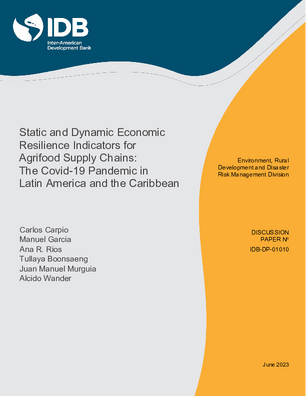Static and Dynamic Economic Resilience Indicators for Agrifood Supply Chains: The COVID-19 Pandemic in Latin America and the Caribbean
Date issued
Jun 2023
Subject
Food Industry;
Resilience;
Pandemic;
Supply Chain;
Economic Stabilization;
Small Business;
Agroindustry;
Environmental Indicator;
Coronavirus;
Agricultural Production;
Business Productivity
JEL code
Q10 - Agriculture: General;
Q13 - Agricultural Markets and Marketing • Cooperatives • Agribusiness
Category
Discussion Papers
Given its enormous adverse effects on production systems and the economy, the recent COVID-19 pandemic has heightened interest in studying resilience in agrifood systems; however, only a few studies have used formal methods for resilience measurement. This study's overall objective was to identify, develop, and use indicators to measure the resilience of the agrifood supply chain. Specific research objectives were 1) to identify and develop survey-based indicators of the economic resilience of agribusinesses; 2) to use the indicators to measure and analyze the economic resilience of the agrifood supply chain in Latin America and the Caribbean (LAC) to the COVID-19 pandemic; and 3) to evaluate differences in the economic resilience of agribusinesses in the different supply chain stages to the COVID-19 pandemic. Data for the study were collected through two online surveys conducted in 2020 and 2022. Two resilience indicators were identified and developed: a static (SRES) and a dynamic (DRES) indicator.
SRES measures the ability of businesses to avoid business losses within each study period. DRES measures firms capacity to recover business activity after an initial negative revenue shock. Study results reflect that, on average, the LAC agrifood supply chain firms in the sample were able to adapt and recover from the disruptions of a global health pandemic. The effects of the pandemic were not homogeneous across firms, nor was their adaptive resilience to the disruption.
SRES measures the ability of businesses to avoid business losses within each study period. DRES measures firms capacity to recover business activity after an initial negative revenue shock. Study results reflect that, on average, the LAC agrifood supply chain firms in the sample were able to adapt and recover from the disruptions of a global health pandemic. The effects of the pandemic were not homogeneous across firms, nor was their adaptive resilience to the disruption.



